Zara: The World's Largest Fashion Retailer - Competitive Situation and Internal Functioning Analysis
VerifiedAdded on 2023/06/16
|9
|2220
|259
AI Summary
This article analyzes the competitive situation and internal functioning of Zara, the world's largest fashion retailer, through a case study. It discusses Zara's value chain activities, supply chain management, and market dominance strategies. The article also includes a SWOT analysis and demographic data on Zara's market area in Asia.
Contribute Materials
Your contribution can guide someone’s learning journey. Share your
documents today.
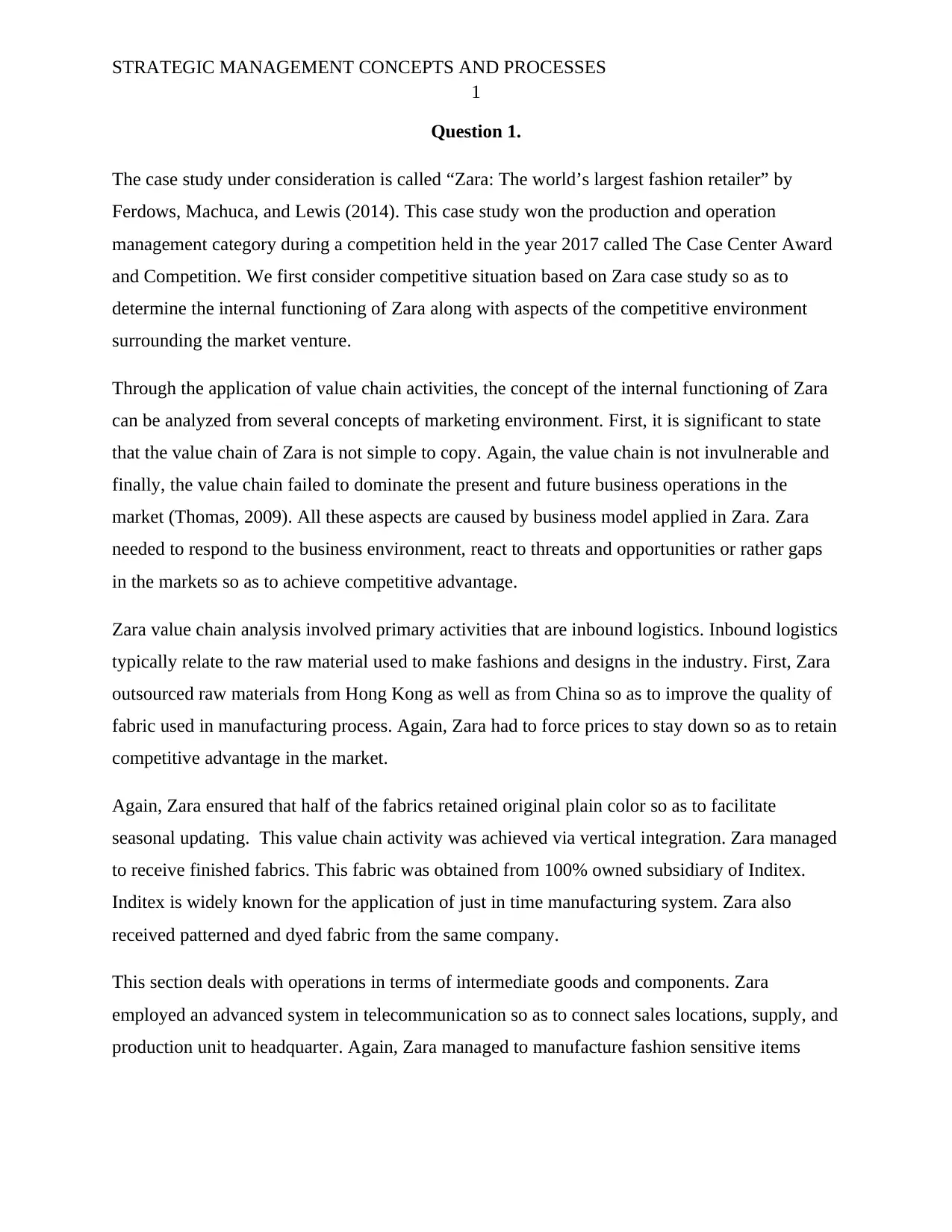
STRATEGIC MANAGEMENT CONCEPTS AND PROCESSES
1
Question 1.
The case study under consideration is called “Zara: The world’s largest fashion retailer” by
Ferdows, Machuca, and Lewis (2014). This case study won the production and operation
management category during a competition held in the year 2017 called The Case Center Award
and Competition. We first consider competitive situation based on Zara case study so as to
determine the internal functioning of Zara along with aspects of the competitive environment
surrounding the market venture.
Through the application of value chain activities, the concept of the internal functioning of Zara
can be analyzed from several concepts of marketing environment. First, it is significant to state
that the value chain of Zara is not simple to copy. Again, the value chain is not invulnerable and
finally, the value chain failed to dominate the present and future business operations in the
market (Thomas, 2009). All these aspects are caused by business model applied in Zara. Zara
needed to respond to the business environment, react to threats and opportunities or rather gaps
in the markets so as to achieve competitive advantage.
Zara value chain analysis involved primary activities that are inbound logistics. Inbound logistics
typically relate to the raw material used to make fashions and designs in the industry. First, Zara
outsourced raw materials from Hong Kong as well as from China so as to improve the quality of
fabric used in manufacturing process. Again, Zara had to force prices to stay down so as to retain
competitive advantage in the market.
Again, Zara ensured that half of the fabrics retained original plain color so as to facilitate
seasonal updating. This value chain activity was achieved via vertical integration. Zara managed
to receive finished fabrics. This fabric was obtained from 100% owned subsidiary of Inditex.
Inditex is widely known for the application of just in time manufacturing system. Zara also
received patterned and dyed fabric from the same company.
This section deals with operations in terms of intermediate goods and components. Zara
employed an advanced system in telecommunication so as to connect sales locations, supply, and
production unit to headquarter. Again, Zara managed to manufacture fashion sensitive items
1
Question 1.
The case study under consideration is called “Zara: The world’s largest fashion retailer” by
Ferdows, Machuca, and Lewis (2014). This case study won the production and operation
management category during a competition held in the year 2017 called The Case Center Award
and Competition. We first consider competitive situation based on Zara case study so as to
determine the internal functioning of Zara along with aspects of the competitive environment
surrounding the market venture.
Through the application of value chain activities, the concept of the internal functioning of Zara
can be analyzed from several concepts of marketing environment. First, it is significant to state
that the value chain of Zara is not simple to copy. Again, the value chain is not invulnerable and
finally, the value chain failed to dominate the present and future business operations in the
market (Thomas, 2009). All these aspects are caused by business model applied in Zara. Zara
needed to respond to the business environment, react to threats and opportunities or rather gaps
in the markets so as to achieve competitive advantage.
Zara value chain analysis involved primary activities that are inbound logistics. Inbound logistics
typically relate to the raw material used to make fashions and designs in the industry. First, Zara
outsourced raw materials from Hong Kong as well as from China so as to improve the quality of
fabric used in manufacturing process. Again, Zara had to force prices to stay down so as to retain
competitive advantage in the market.
Again, Zara ensured that half of the fabrics retained original plain color so as to facilitate
seasonal updating. This value chain activity was achieved via vertical integration. Zara managed
to receive finished fabrics. This fabric was obtained from 100% owned subsidiary of Inditex.
Inditex is widely known for the application of just in time manufacturing system. Zara also
received patterned and dyed fabric from the same company.
This section deals with operations in terms of intermediate goods and components. Zara
employed an advanced system in telecommunication so as to connect sales locations, supply, and
production unit to headquarter. Again, Zara managed to manufacture fashion sensitive items
Secure Best Marks with AI Grader
Need help grading? Try our AI Grader for instant feedback on your assignments.
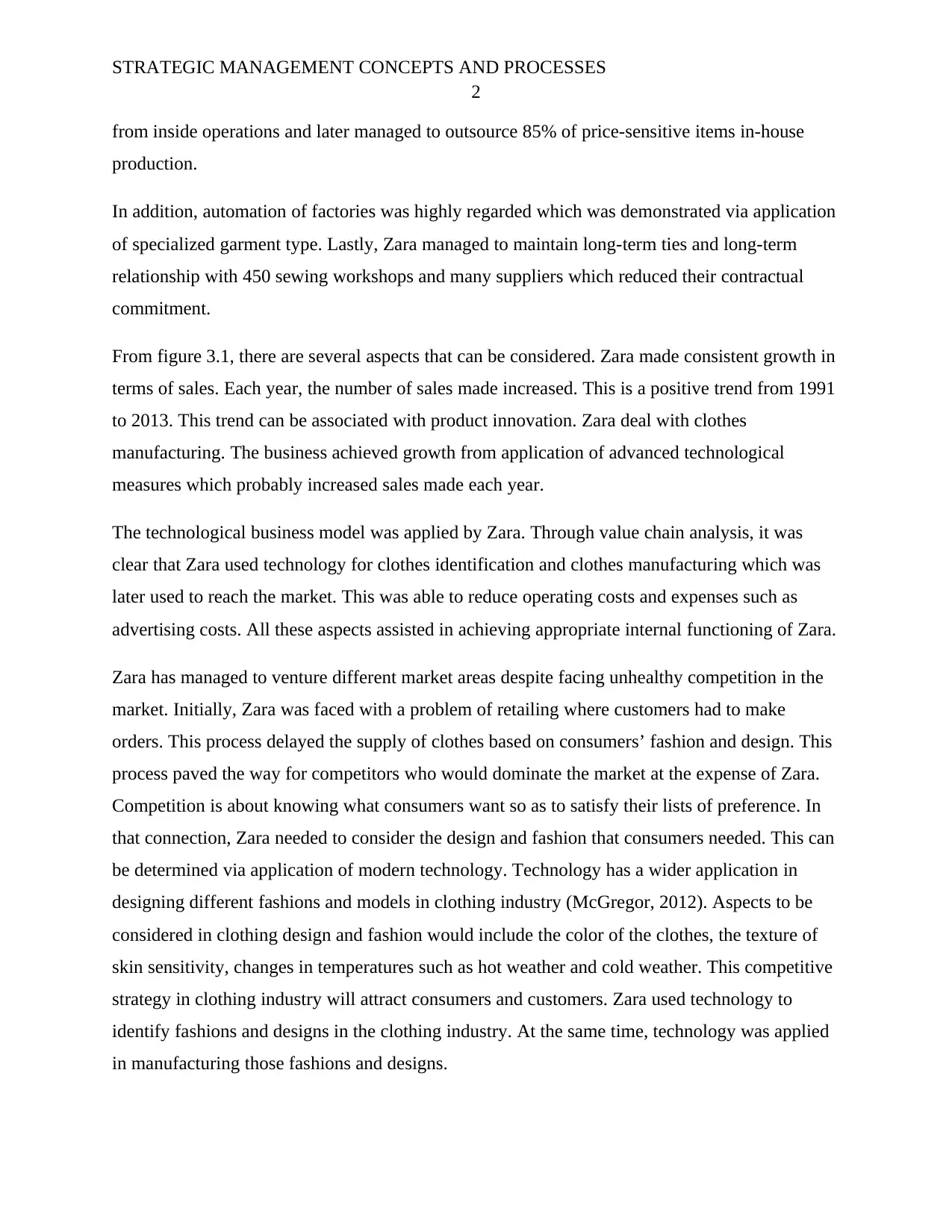
STRATEGIC MANAGEMENT CONCEPTS AND PROCESSES
2
from inside operations and later managed to outsource 85% of price-sensitive items in-house
production.
In addition, automation of factories was highly regarded which was demonstrated via application
of specialized garment type. Lastly, Zara managed to maintain long-term ties and long-term
relationship with 450 sewing workshops and many suppliers which reduced their contractual
commitment.
From figure 3.1, there are several aspects that can be considered. Zara made consistent growth in
terms of sales. Each year, the number of sales made increased. This is a positive trend from 1991
to 2013. This trend can be associated with product innovation. Zara deal with clothes
manufacturing. The business achieved growth from application of advanced technological
measures which probably increased sales made each year.
The technological business model was applied by Zara. Through value chain analysis, it was
clear that Zara used technology for clothes identification and clothes manufacturing which was
later used to reach the market. This was able to reduce operating costs and expenses such as
advertising costs. All these aspects assisted in achieving appropriate internal functioning of Zara.
Zara has managed to venture different market areas despite facing unhealthy competition in the
market. Initially, Zara was faced with a problem of retailing where customers had to make
orders. This process delayed the supply of clothes based on consumers’ fashion and design. This
process paved the way for competitors who would dominate the market at the expense of Zara.
Competition is about knowing what consumers want so as to satisfy their lists of preference. In
that connection, Zara needed to consider the design and fashion that consumers needed. This can
be determined via application of modern technology. Technology has a wider application in
designing different fashions and models in clothing industry (McGregor, 2012). Aspects to be
considered in clothing design and fashion would include the color of the clothes, the texture of
skin sensitivity, changes in temperatures such as hot weather and cold weather. This competitive
strategy in clothing industry will attract consumers and customers. Zara used technology to
identify fashions and designs in the clothing industry. At the same time, technology was applied
in manufacturing those fashions and designs.
2
from inside operations and later managed to outsource 85% of price-sensitive items in-house
production.
In addition, automation of factories was highly regarded which was demonstrated via application
of specialized garment type. Lastly, Zara managed to maintain long-term ties and long-term
relationship with 450 sewing workshops and many suppliers which reduced their contractual
commitment.
From figure 3.1, there are several aspects that can be considered. Zara made consistent growth in
terms of sales. Each year, the number of sales made increased. This is a positive trend from 1991
to 2013. This trend can be associated with product innovation. Zara deal with clothes
manufacturing. The business achieved growth from application of advanced technological
measures which probably increased sales made each year.
The technological business model was applied by Zara. Through value chain analysis, it was
clear that Zara used technology for clothes identification and clothes manufacturing which was
later used to reach the market. This was able to reduce operating costs and expenses such as
advertising costs. All these aspects assisted in achieving appropriate internal functioning of Zara.
Zara has managed to venture different market areas despite facing unhealthy competition in the
market. Initially, Zara was faced with a problem of retailing where customers had to make
orders. This process delayed the supply of clothes based on consumers’ fashion and design. This
process paved the way for competitors who would dominate the market at the expense of Zara.
Competition is about knowing what consumers want so as to satisfy their lists of preference. In
that connection, Zara needed to consider the design and fashion that consumers needed. This can
be determined via application of modern technology. Technology has a wider application in
designing different fashions and models in clothing industry (McGregor, 2012). Aspects to be
considered in clothing design and fashion would include the color of the clothes, the texture of
skin sensitivity, changes in temperatures such as hot weather and cold weather. This competitive
strategy in clothing industry will attract consumers and customers. Zara used technology to
identify fashions and designs in the clothing industry. At the same time, technology was applied
in manufacturing those fashions and designs.
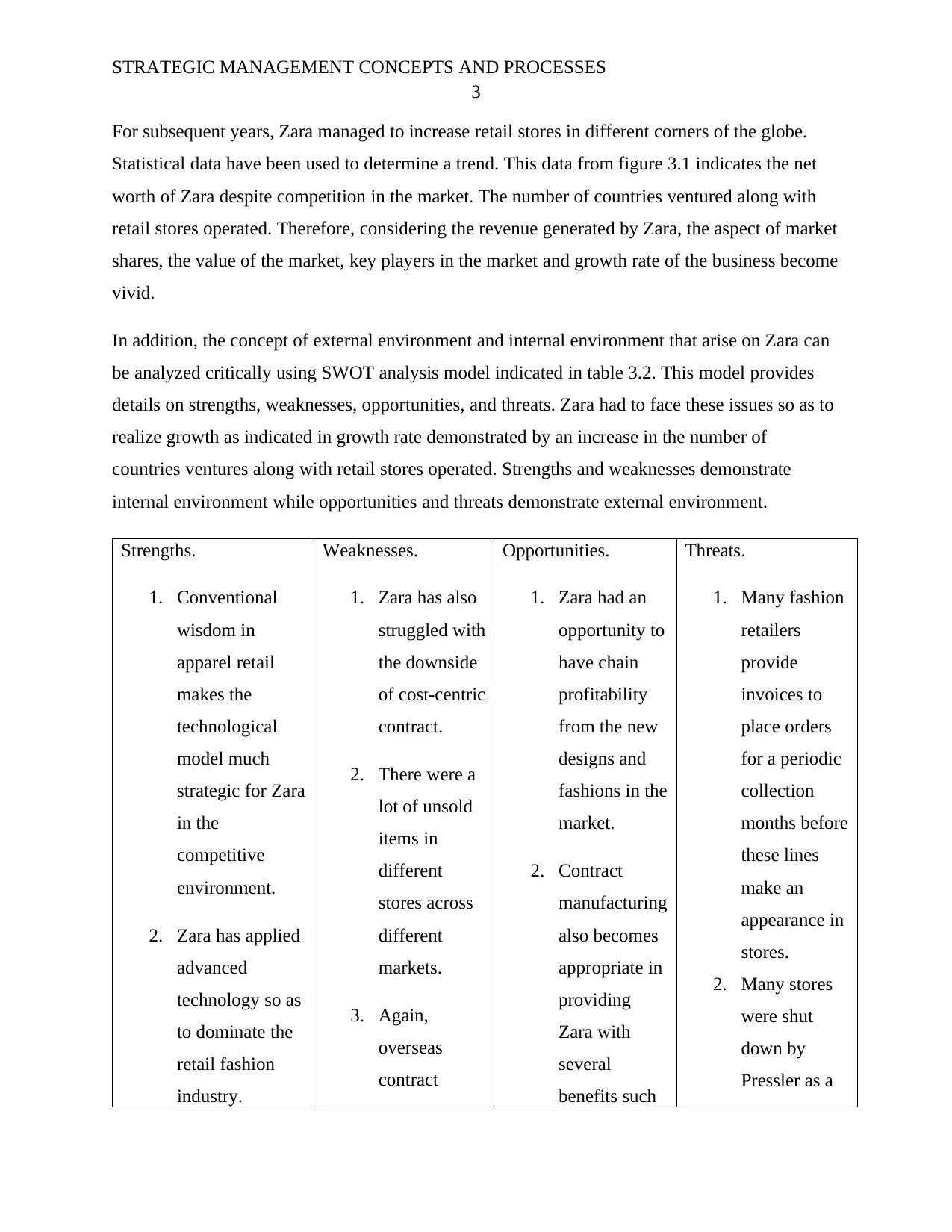
STRATEGIC MANAGEMENT CONCEPTS AND PROCESSES
3
For subsequent years, Zara managed to increase retail stores in different corners of the globe.
Statistical data have been used to determine a trend. This data from figure 3.1 indicates the net
worth of Zara despite competition in the market. The number of countries ventured along with
retail stores operated. Therefore, considering the revenue generated by Zara, the aspect of market
shares, the value of the market, key players in the market and growth rate of the business become
vivid.
In addition, the concept of external environment and internal environment that arise on Zara can
be analyzed critically using SWOT analysis model indicated in table 3.2. This model provides
details on strengths, weaknesses, opportunities, and threats. Zara had to face these issues so as to
realize growth as indicated in growth rate demonstrated by an increase in the number of
countries ventures along with retail stores operated. Strengths and weaknesses demonstrate
internal environment while opportunities and threats demonstrate external environment.
Strengths.
1. Conventional
wisdom in
apparel retail
makes the
technological
model much
strategic for Zara
in the
competitive
environment.
2. Zara has applied
advanced
technology so as
to dominate the
retail fashion
industry.
Weaknesses.
1. Zara has also
struggled with
the downside
of cost-centric
contract.
2. There were a
lot of unsold
items in
different
stores across
different
markets.
3. Again,
overseas
contract
Opportunities.
1. Zara had an
opportunity to
have chain
profitability
from the new
designs and
fashions in the
market.
2. Contract
manufacturing
also becomes
appropriate in
providing
Zara with
several
benefits such
Threats.
1. Many fashion
retailers
provide
invoices to
place orders
for a periodic
collection
months before
these lines
make an
appearance in
stores.
2. Many stores
were shut
down by
Pressler as a
3
For subsequent years, Zara managed to increase retail stores in different corners of the globe.
Statistical data have been used to determine a trend. This data from figure 3.1 indicates the net
worth of Zara despite competition in the market. The number of countries ventured along with
retail stores operated. Therefore, considering the revenue generated by Zara, the aspect of market
shares, the value of the market, key players in the market and growth rate of the business become
vivid.
In addition, the concept of external environment and internal environment that arise on Zara can
be analyzed critically using SWOT analysis model indicated in table 3.2. This model provides
details on strengths, weaknesses, opportunities, and threats. Zara had to face these issues so as to
realize growth as indicated in growth rate demonstrated by an increase in the number of
countries ventures along with retail stores operated. Strengths and weaknesses demonstrate
internal environment while opportunities and threats demonstrate external environment.
Strengths.
1. Conventional
wisdom in
apparel retail
makes the
technological
model much
strategic for Zara
in the
competitive
environment.
2. Zara has applied
advanced
technology so as
to dominate the
retail fashion
industry.
Weaknesses.
1. Zara has also
struggled with
the downside
of cost-centric
contract.
2. There were a
lot of unsold
items in
different
stores across
different
markets.
3. Again,
overseas
contract
Opportunities.
1. Zara had an
opportunity to
have chain
profitability
from the new
designs and
fashions in the
market.
2. Contract
manufacturing
also becomes
appropriate in
providing
Zara with
several
benefits such
Threats.
1. Many fashion
retailers
provide
invoices to
place orders
for a periodic
collection
months before
these lines
make an
appearance in
stores.
2. Many stores
were shut
down by
Pressler as a
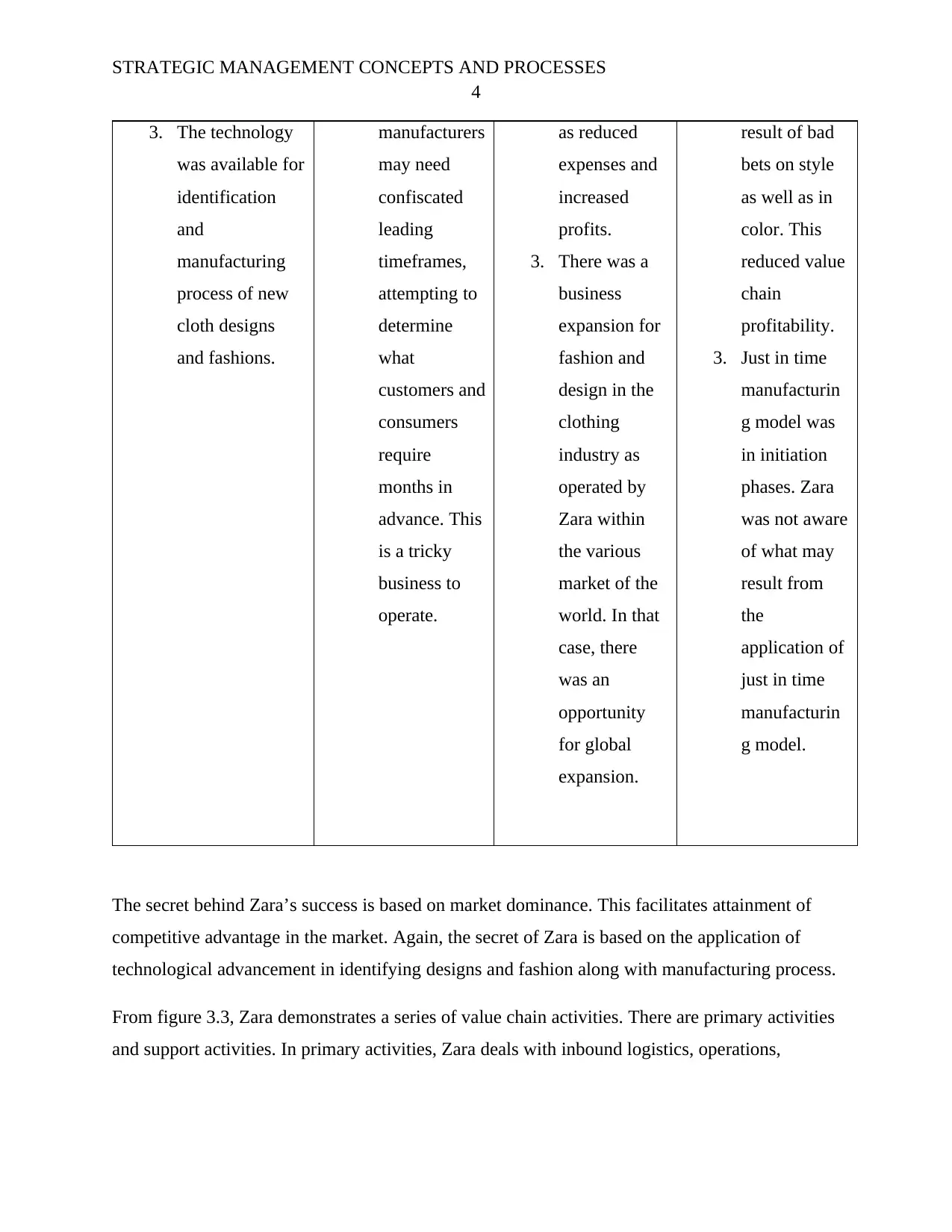
STRATEGIC MANAGEMENT CONCEPTS AND PROCESSES
4
3. The technology
was available for
identification
and
manufacturing
process of new
cloth designs
and fashions.
manufacturers
may need
confiscated
leading
timeframes,
attempting to
determine
what
customers and
consumers
require
months in
advance. This
is a tricky
business to
operate.
as reduced
expenses and
increased
profits.
3. There was a
business
expansion for
fashion and
design in the
clothing
industry as
operated by
Zara within
the various
market of the
world. In that
case, there
was an
opportunity
for global
expansion.
result of bad
bets on style
as well as in
color. This
reduced value
chain
profitability.
3. Just in time
manufacturin
g model was
in initiation
phases. Zara
was not aware
of what may
result from
the
application of
just in time
manufacturin
g model.
The secret behind Zara’s success is based on market dominance. This facilitates attainment of
competitive advantage in the market. Again, the secret of Zara is based on the application of
technological advancement in identifying designs and fashion along with manufacturing process.
From figure 3.3, Zara demonstrates a series of value chain activities. There are primary activities
and support activities. In primary activities, Zara deals with inbound logistics, operations,
4
3. The technology
was available for
identification
and
manufacturing
process of new
cloth designs
and fashions.
manufacturers
may need
confiscated
leading
timeframes,
attempting to
determine
what
customers and
consumers
require
months in
advance. This
is a tricky
business to
operate.
as reduced
expenses and
increased
profits.
3. There was a
business
expansion for
fashion and
design in the
clothing
industry as
operated by
Zara within
the various
market of the
world. In that
case, there
was an
opportunity
for global
expansion.
result of bad
bets on style
as well as in
color. This
reduced value
chain
profitability.
3. Just in time
manufacturin
g model was
in initiation
phases. Zara
was not aware
of what may
result from
the
application of
just in time
manufacturin
g model.
The secret behind Zara’s success is based on market dominance. This facilitates attainment of
competitive advantage in the market. Again, the secret of Zara is based on the application of
technological advancement in identifying designs and fashion along with manufacturing process.
From figure 3.3, Zara demonstrates a series of value chain activities. There are primary activities
and support activities. In primary activities, Zara deals with inbound logistics, operations,
Secure Best Marks with AI Grader
Need help grading? Try our AI Grader for instant feedback on your assignments.
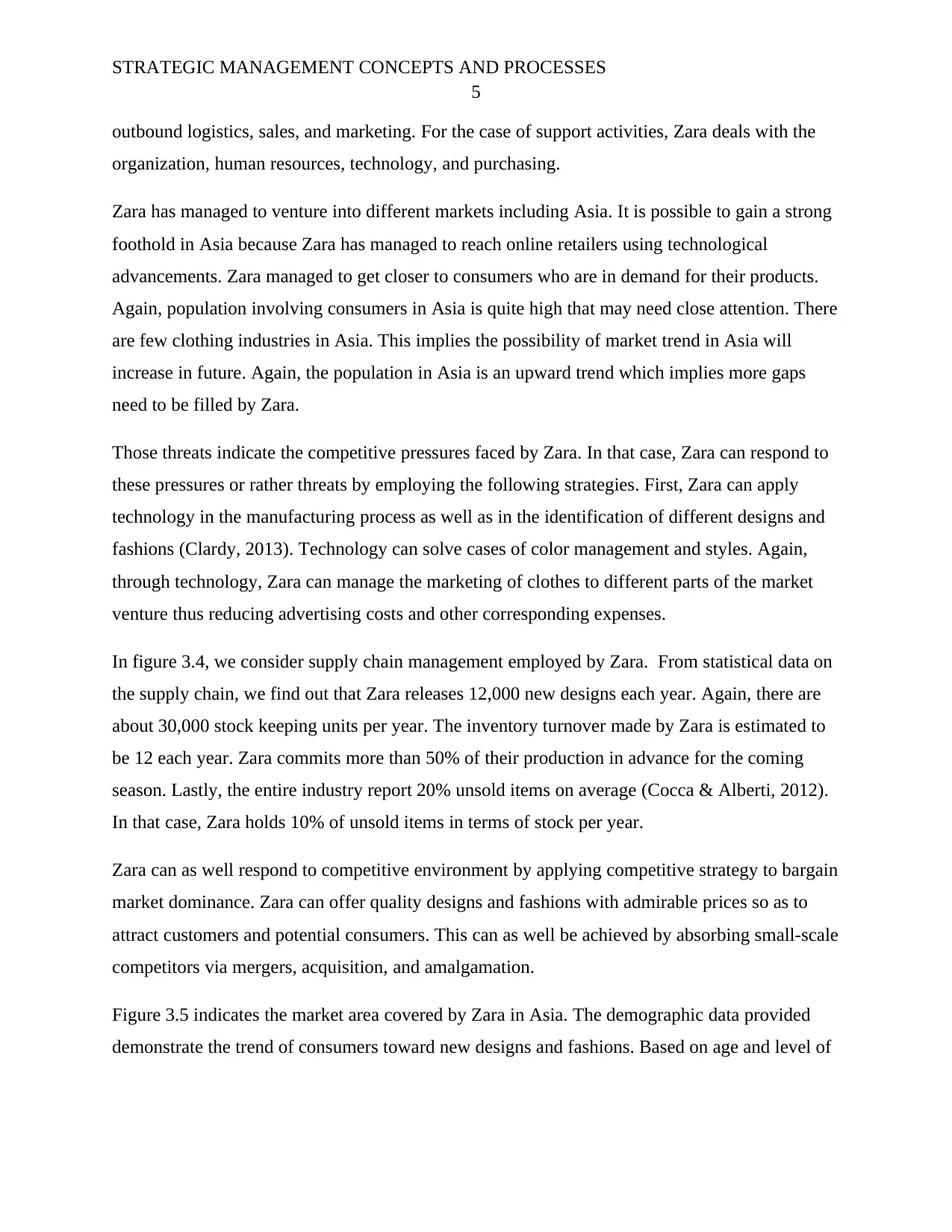
STRATEGIC MANAGEMENT CONCEPTS AND PROCESSES
5
outbound logistics, sales, and marketing. For the case of support activities, Zara deals with the
organization, human resources, technology, and purchasing.
Zara has managed to venture into different markets including Asia. It is possible to gain a strong
foothold in Asia because Zara has managed to reach online retailers using technological
advancements. Zara managed to get closer to consumers who are in demand for their products.
Again, population involving consumers in Asia is quite high that may need close attention. There
are few clothing industries in Asia. This implies the possibility of market trend in Asia will
increase in future. Again, the population in Asia is an upward trend which implies more gaps
need to be filled by Zara.
Those threats indicate the competitive pressures faced by Zara. In that case, Zara can respond to
these pressures or rather threats by employing the following strategies. First, Zara can apply
technology in the manufacturing process as well as in the identification of different designs and
fashions (Clardy, 2013). Technology can solve cases of color management and styles. Again,
through technology, Zara can manage the marketing of clothes to different parts of the market
venture thus reducing advertising costs and other corresponding expenses.
In figure 3.4, we consider supply chain management employed by Zara. From statistical data on
the supply chain, we find out that Zara releases 12,000 new designs each year. Again, there are
about 30,000 stock keeping units per year. The inventory turnover made by Zara is estimated to
be 12 each year. Zara commits more than 50% of their production in advance for the coming
season. Lastly, the entire industry report 20% unsold items on average (Cocca & Alberti, 2012).
In that case, Zara holds 10% of unsold items in terms of stock per year.
Zara can as well respond to competitive environment by applying competitive strategy to bargain
market dominance. Zara can offer quality designs and fashions with admirable prices so as to
attract customers and potential consumers. This can as well be achieved by absorbing small-scale
competitors via mergers, acquisition, and amalgamation.
Figure 3.5 indicates the market area covered by Zara in Asia. The demographic data provided
demonstrate the trend of consumers toward new designs and fashions. Based on age and level of
5
outbound logistics, sales, and marketing. For the case of support activities, Zara deals with the
organization, human resources, technology, and purchasing.
Zara has managed to venture into different markets including Asia. It is possible to gain a strong
foothold in Asia because Zara has managed to reach online retailers using technological
advancements. Zara managed to get closer to consumers who are in demand for their products.
Again, population involving consumers in Asia is quite high that may need close attention. There
are few clothing industries in Asia. This implies the possibility of market trend in Asia will
increase in future. Again, the population in Asia is an upward trend which implies more gaps
need to be filled by Zara.
Those threats indicate the competitive pressures faced by Zara. In that case, Zara can respond to
these pressures or rather threats by employing the following strategies. First, Zara can apply
technology in the manufacturing process as well as in the identification of different designs and
fashions (Clardy, 2013). Technology can solve cases of color management and styles. Again,
through technology, Zara can manage the marketing of clothes to different parts of the market
venture thus reducing advertising costs and other corresponding expenses.
In figure 3.4, we consider supply chain management employed by Zara. From statistical data on
the supply chain, we find out that Zara releases 12,000 new designs each year. Again, there are
about 30,000 stock keeping units per year. The inventory turnover made by Zara is estimated to
be 12 each year. Zara commits more than 50% of their production in advance for the coming
season. Lastly, the entire industry report 20% unsold items on average (Cocca & Alberti, 2012).
In that case, Zara holds 10% of unsold items in terms of stock per year.
Zara can as well respond to competitive environment by applying competitive strategy to bargain
market dominance. Zara can offer quality designs and fashions with admirable prices so as to
attract customers and potential consumers. This can as well be achieved by absorbing small-scale
competitors via mergers, acquisition, and amalgamation.
Figure 3.5 indicates the market area covered by Zara in Asia. The demographic data provided
demonstrate the trend of consumers toward new designs and fashions. Based on age and level of
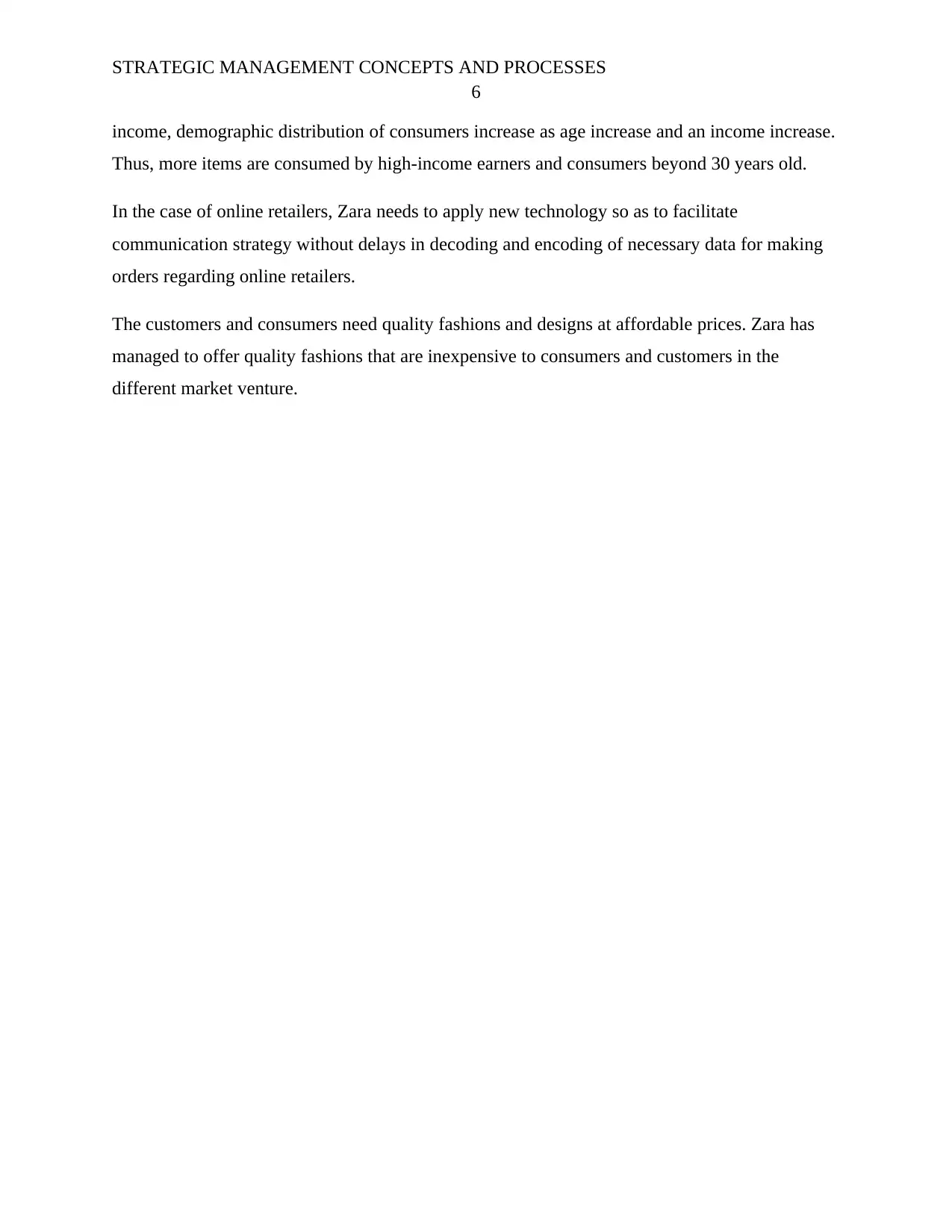
STRATEGIC MANAGEMENT CONCEPTS AND PROCESSES
6
income, demographic distribution of consumers increase as age increase and an income increase.
Thus, more items are consumed by high-income earners and consumers beyond 30 years old.
In the case of online retailers, Zara needs to apply new technology so as to facilitate
communication strategy without delays in decoding and encoding of necessary data for making
orders regarding online retailers.
The customers and consumers need quality fashions and designs at affordable prices. Zara has
managed to offer quality fashions that are inexpensive to consumers and customers in the
different market venture.
6
income, demographic distribution of consumers increase as age increase and an income increase.
Thus, more items are consumed by high-income earners and consumers beyond 30 years old.
In the case of online retailers, Zara needs to apply new technology so as to facilitate
communication strategy without delays in decoding and encoding of necessary data for making
orders regarding online retailers.
The customers and consumers need quality fashions and designs at affordable prices. Zara has
managed to offer quality fashions that are inexpensive to consumers and customers in the
different market venture.
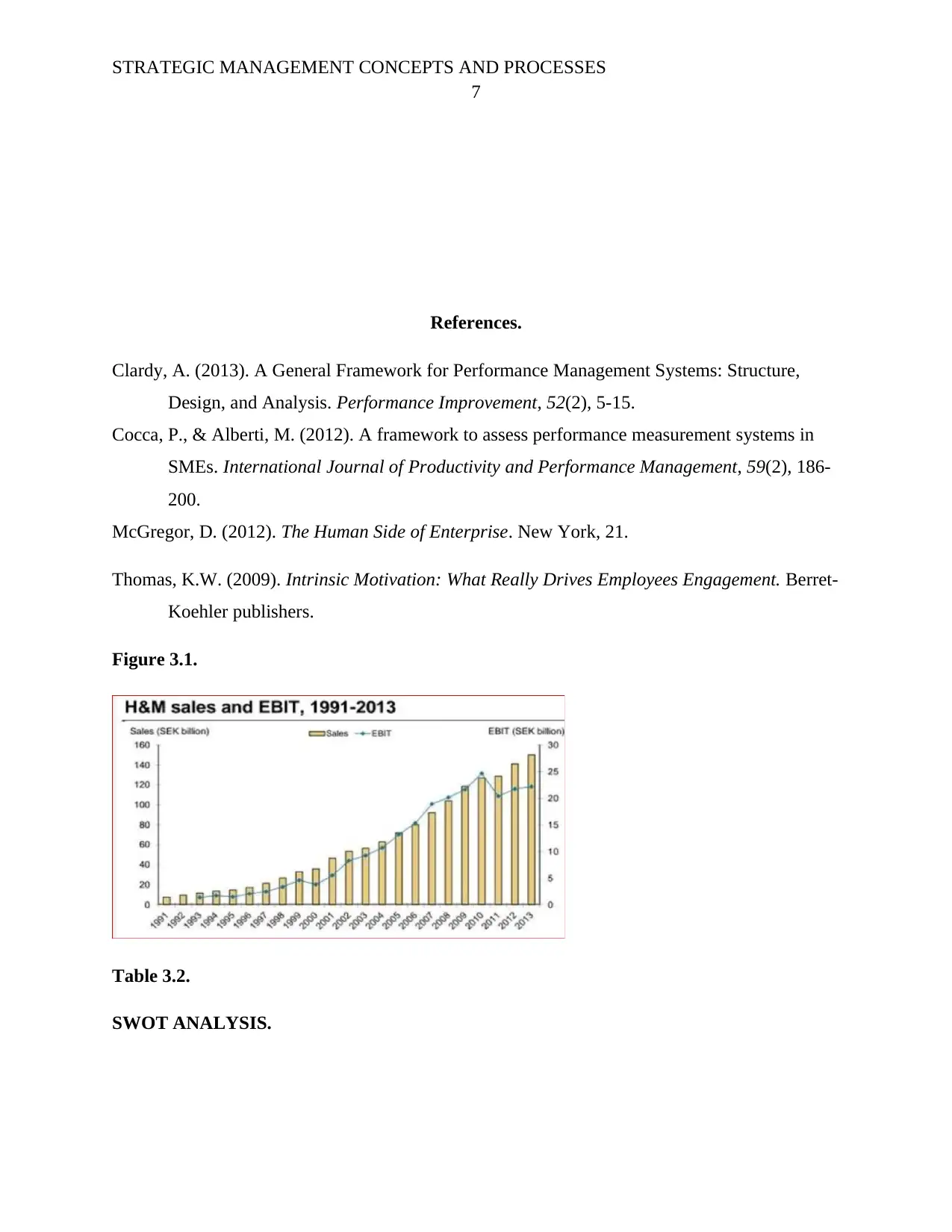
STRATEGIC MANAGEMENT CONCEPTS AND PROCESSES
7
References.
Clardy, A. (2013). A General Framework for Performance Management Systems: Structure,
Design, and Analysis. Performance Improvement, 52(2), 5-15.
Cocca, P., & Alberti, M. (2012). A framework to assess performance measurement systems in
SMEs. International Journal of Productivity and Performance Management, 59(2), 186-
200.
McGregor, D. (2012). The Human Side of Enterprise. New York, 21.
Thomas, K.W. (2009). Intrinsic Motivation: What Really Drives Employees Engagement. Berret-
Koehler publishers.
Figure 3.1.
Table 3.2.
SWOT ANALYSIS.
7
References.
Clardy, A. (2013). A General Framework for Performance Management Systems: Structure,
Design, and Analysis. Performance Improvement, 52(2), 5-15.
Cocca, P., & Alberti, M. (2012). A framework to assess performance measurement systems in
SMEs. International Journal of Productivity and Performance Management, 59(2), 186-
200.
McGregor, D. (2012). The Human Side of Enterprise. New York, 21.
Thomas, K.W. (2009). Intrinsic Motivation: What Really Drives Employees Engagement. Berret-
Koehler publishers.
Figure 3.1.
Table 3.2.
SWOT ANALYSIS.
Paraphrase This Document
Need a fresh take? Get an instant paraphrase of this document with our AI Paraphraser
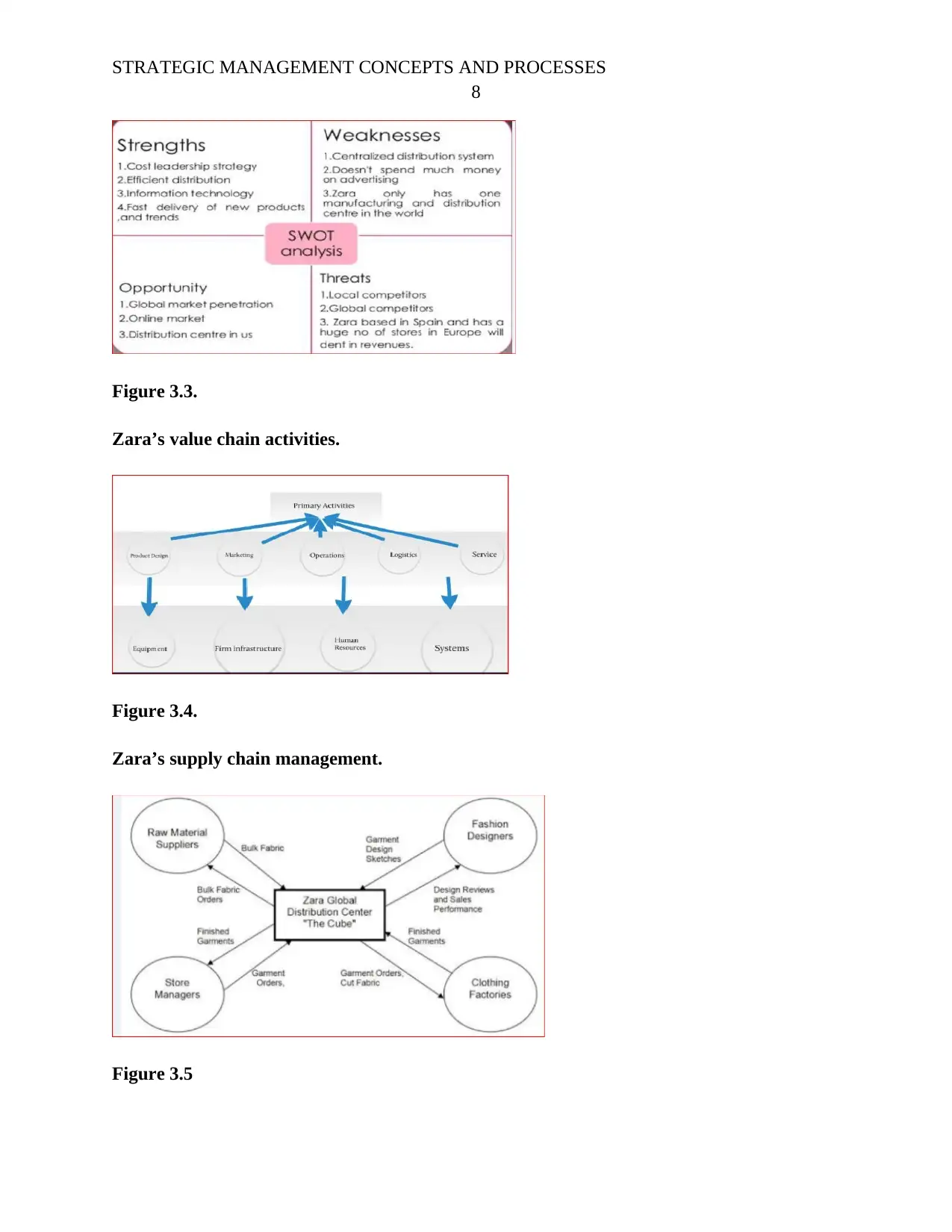
STRATEGIC MANAGEMENT CONCEPTS AND PROCESSES
8
Figure 3.3.
Zara’s value chain activities.
Figure 3.4.
Zara’s supply chain management.
Figure 3.5
8
Figure 3.3.
Zara’s value chain activities.
Figure 3.4.
Zara’s supply chain management.
Figure 3.5
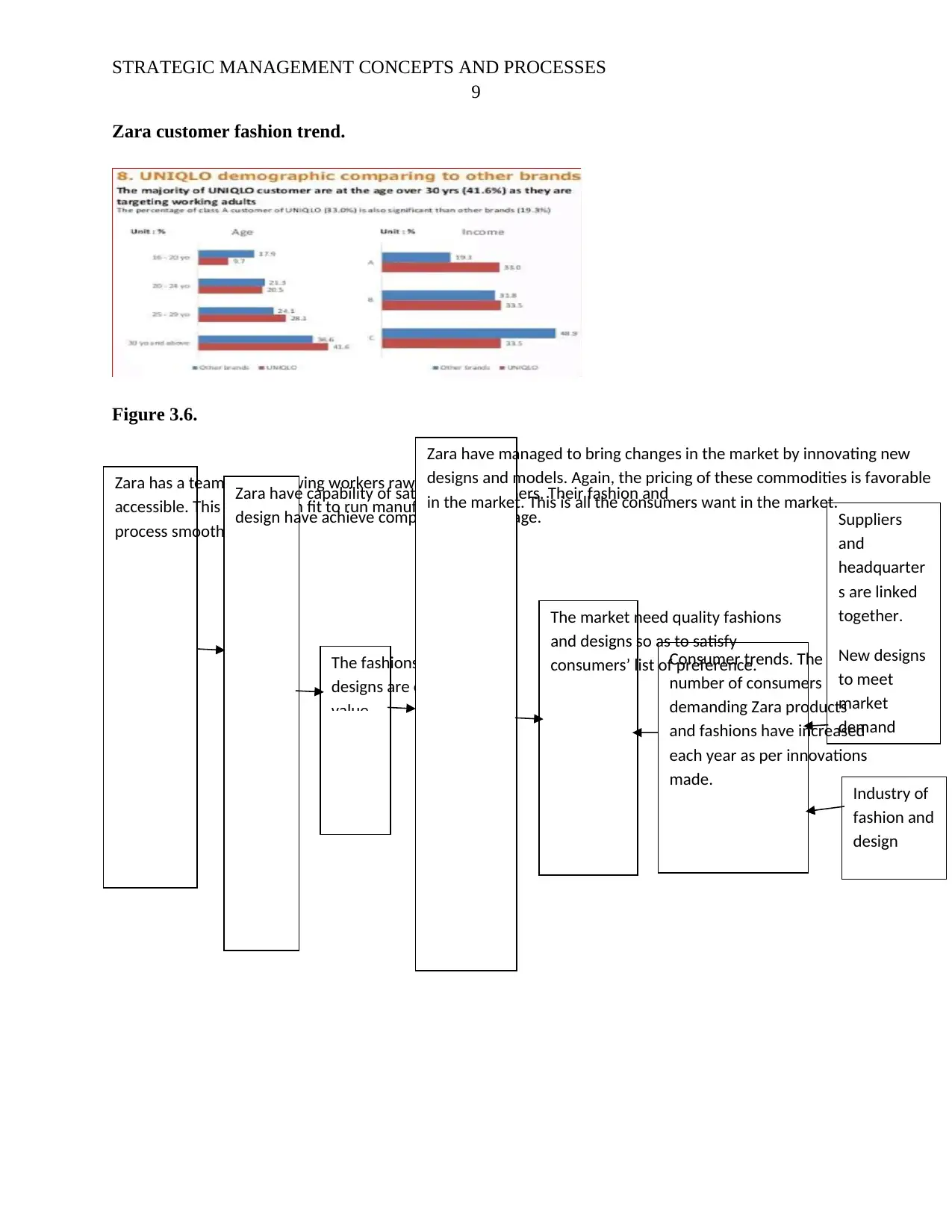
STRATEGIC MANAGEMENT CONCEPTS AND PROCESSES
9
Zara customer fashion trend.
Figure 3.6.
Zara has a team of 450 sewing workers raw material are
accessible. This make them fit to run manufacturing
process smoothly.
Zara have capability of satisfying consumers. Their fashion and
design have achieve competitive advantage.
The fashions and
designs are of quality
value
Suppliers
and
headquarter
s are linked
together.
New designs
to meet
market
demand
Consumer trends. The
number of consumers
demanding Zara products
and fashions have increased
each year as per innovations
made. Industry of
fashion and
design
The market need quality fashions
and designs so as to satisfy
consumers’ list of preference.
Zara have managed to bring changes in the market by innovating new
designs and models. Again, the pricing of these commodities is favorable
in the market. This is all the consumers want in the market.
9
Zara customer fashion trend.
Figure 3.6.
Zara has a team of 450 sewing workers raw material are
accessible. This make them fit to run manufacturing
process smoothly.
Zara have capability of satisfying consumers. Their fashion and
design have achieve competitive advantage.
The fashions and
designs are of quality
value
Suppliers
and
headquarter
s are linked
together.
New designs
to meet
market
demand
Consumer trends. The
number of consumers
demanding Zara products
and fashions have increased
each year as per innovations
made. Industry of
fashion and
design
The market need quality fashions
and designs so as to satisfy
consumers’ list of preference.
Zara have managed to bring changes in the market by innovating new
designs and models. Again, the pricing of these commodities is favorable
in the market. This is all the consumers want in the market.
1 out of 9
Related Documents
Your All-in-One AI-Powered Toolkit for Academic Success.
+13062052269
info@desklib.com
Available 24*7 on WhatsApp / Email
![[object Object]](/_next/static/media/star-bottom.7253800d.svg)
Unlock your academic potential
© 2024 | Zucol Services PVT LTD | All rights reserved.





